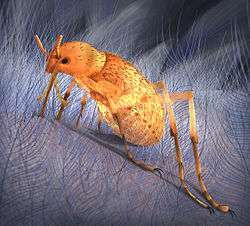Pseudopulex
| Pseudopulex Temporal range: Middle Jurassic to Early Cretaceous, 165–125 Ma | |
|---|---|
 | |
| Restoration of P. jurassicus | |
| Scientific classification | |
| Kingdom: | Animalia |
| Phylum: | Arthropoda |
| Class: | Insecta |
| Order: | incertae sedis |
| Family: | Pseudopulicidae |
| Genus: | Pseudopulex Tai-ping Gao, Chung-kun Shih, Xing Xu, Shuo Wan, Dong Ren, 2012 |
| Species | |
| |
Pseudopulex is a genus of extinct, flea-like, parasitic insects that once fed on dinosaurs.[1]
The two species, Pseudopulex jurassicus and Pseudopulex magnus, are similar to modern fleas, but their bodies were more compressed, and they had longer claws which they used to hold on tightly to dinosaurs or pterosaurs. They were also 10 times as large as modern fleas and possessed serrated stylets, likely for feeding on blood through thick layers of skin.[2]
Discovery
Fossils of Pseudopulex jurassicus are known from the middle Jurassic-aged Jiulongshan Formation, 165 million years old.[3] Fossils of Pseudopulex magnus are from the Early Cretaceous Yixian Formation, 125 million years old.
References
- ↑ "'Giant flea fed on dinosaur blood like mosquitoes' - NY Daily News". India.nydailynews.com. Retrieved 2012-05-02.
- ↑ Gao, Tai-ping; Shih, Chung-kun; Xu, Xing; Wang, Shuo; Ren, Dong (1 April 2012). "Mid-Mesozoic Flea-like Ectoparasites of Feathered or Haired Vertebrates". Current Biology. 22 (8): 732–735. doi:10.1016/j.cub.2012.03.012.
- ↑ "Ancient fleas plagued ancient dinosaurs". UPI.com. Retrieved 2012-05-02.
| Wikispecies has information related to: Pseudopulex |
This article is issued from Wikipedia - version of the 8/27/2016. The text is available under the Creative Commons Attribution/Share Alike but additional terms may apply for the media files.
